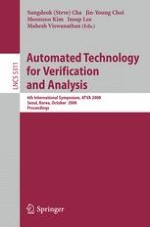This book constitutes the refereed proceedings of the 6th International Symposium on Automated Technology for Verification and Analysis, ATVA 2008, held in Seoul, Korea, in October 2008. The 21 revised full papers 5 short papers and 7 tool papers presented together with 3 invited talks were carefully reviewed and selected from 82 submissions. The focos lies on theoretical methods to achieve correct software or hardware systems, including both functional and non functional aspects; as well as on applications of theory in engineering methods and particular domains and handling of practical problems occurring in tools. The papers are organized in topical sections on model checking, software verification, decision procedures, linear-time analysis, tool demonstration papers, timed and stochastic systems, theory, and short papers.
